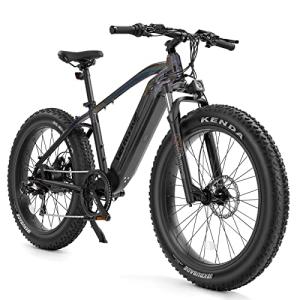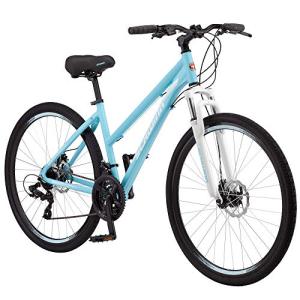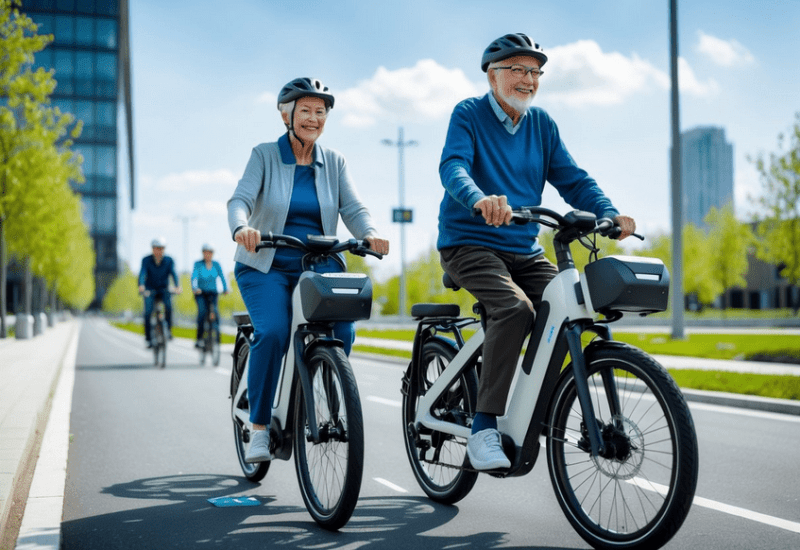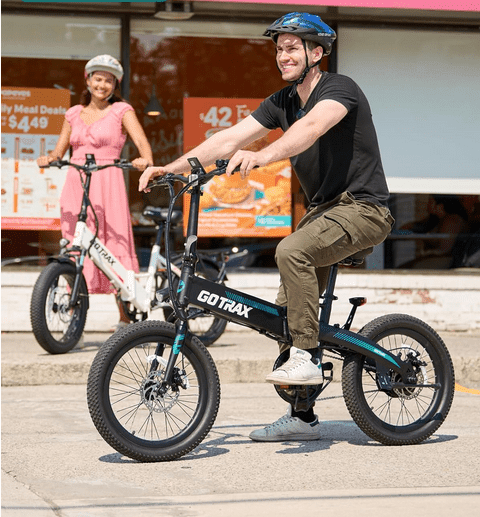Winter brings new challenges for e-bike riders. Snow and ice can make roads slippery and hard to navigate. But with the right know-how, you can keep riding safely all season long.

Proper gear and bike maintenance are key to safe winter e-biking. Good tires, warm clothes, and a well-tuned bike help you stay safe on icy roads. It's also smart to slow down and be extra careful when turning or braking.
E-bikes can be great for winter travel. Their motors give you extra power to get through snow. Plus, you won't get as sweaty as you might on a regular bike. This means you'll stay warmer and drier on your rides.
Key Takeaways
- Prepare your e-bike with winter-ready tires and regular maintenance
- Wear warm, visible clothing and use lights for safety
- Ride slowly and carefully, especially on turns and when braking
Understanding Winter Cycling Risks

Winter e-bike riding comes with unique challenges. Cold weather affects bike performance, while snowy and icy roads create hazards for cyclists.
Effects of Cold Weather on E-Bike Performance
Cold temperatures can reduce battery life in e-bikes. Batteries may lose up to 50% of their charge in freezing conditions. This means shorter riding distances and less power assistance.
Extreme cold can also make metal parts brittle. Brake lines and cables may become stiff, affecting responsiveness. Tires lose air pressure faster in cold weather, leading to poor traction.
E-bike motors work harder in cold weather. This extra strain can decrease efficiency and potentially cause damage over time.
Common Hazards on Snowy and Icy Roads
Snow and ice create slippery surfaces that reduce tire grip. This increases the risk of skidding and falling, especially when turning or braking.
Black ice is a major danger. It forms a thin, nearly invisible layer on roads and can cause sudden loss of control.
Snowbanks narrow roads and bike lanes. This forces cyclists closer to traffic, raising accident risks.
Road salt and sand used for de-icing can damage e-bike components. They may corrode metal parts or clog moving mechanisms.
Reduced daylight hours in winter make cyclists less visible to drivers. This heightens the chance of collisions, particularly during rush hours.
Prepping Your E-Bike for Winter
Getting your e-bike ready for winter riding takes some important steps. The right prep can keep you safe and your bike running well in cold, snowy conditions.
Choosing the Right Tires
Winter e-bike tires need good traction on slippery surfaces. Fat tires with deep treads grip snow and ice better than regular tires. Some riders use studded tires for extra grip on icy roads.
Wider tires also help spread your weight over a larger surface area. This can prevent you from sinking into soft snow. Consider lowering your tire pressure slightly in winter. It increases the contact patch with the ground.
Check your tire pressure often in cold weather. Air contracts when it's cold, so tires lose pressure faster.
Optimizing Battery Life in Cold Conditions
Cold weather reduces e-bike battery life. Store your battery indoors when not in use. This keeps it warm and ready to go.
Charge your battery at room temperature for best results. Let a cold battery warm up before charging it. Use a neoprene battery cover for extra insulation while riding.
Plan for shorter rides in very cold weather. Your battery won't last as long as it does in summer. Pedal more and use less motor power to extend your range.
Essential E-Bike Maintenance for Winter
Clean and dry your e-bike after each winter ride. Road salt and grime can damage parts if left on. Use a bike-specific degreaser on the chain and gears.
Lubricate your chain more often in winter. Use a wet lube that won't wash off easily in snow and slush.
Check your brakes regularly. Wet conditions can wear them down faster. Make sure all electrical connections are tight and protected from moisture.
Consider sealing vulnerable parts with silicone spray. This helps keep water out of your motor and other electronics.
Riding Safely on Snow and Ice

E-bike riders can stay safe in winter by using proper techniques and being extra cautious. Proper balance and careful braking are key to avoiding accidents on slippery roads.
Techniques for Maintaining Balance
Lower the seat to keep your feet closer to the ground. This helps you catch yourself if you start to slip. Ride at a slower speed to have more control. Keep your body loose and relaxed, not stiff. This allows you to react quickly to changes in the road surface.
Lean slightly into turns to improve traction. Look ahead and plan your route to avoid patches of ice. Consider wider tires with deeper treads for better grip in snow. Studded tires can also provide extra traction on icy roads.
Keep both hands on the handlebars at all times. Avoid sudden movements that could cause you to lose balance. Practice riding in an empty parking lot to get used to winter conditions.
Braking and Cornering on Slippery Surfaces
Use your brakes gently and gradually. Sudden braking can cause your wheels to lock up and skid. Start slowing down well before you need to stop. Use both brakes evenly for more control.
When turning, slow down before the turn, not during it. Take turns wider and more slowly than usual. Lean your body slightly into the turn, but keep the bike more upright. This helps maintain traction.
Avoid braking or turning on visibly icy patches if possible. If you hit ice, stay calm and try to coast straight through it. Don't pedal or brake until you're back on a grippier surface.
Be extra careful on bridges and overpasses. These freeze before other road surfaces. Watch for black ice, especially in shaded areas.
Protective Gear and Clothing

Proper attire and safety equipment are crucial for winter e-bike riding. The right gear keeps you warm, visible, and protected from falls on icy roads.
Layering for Warmth and Mobility
Start with a moisture-wicking base layer to keep sweat away from your skin. Add an insulating mid-layer like fleece or wool for warmth. Top it off with a waterproof, breathable outer shell to block wind and snow.
Choose clothes that allow easy movement while riding. Avoid bulky items that can get caught in your bike's moving parts. Opt for bike-specific winter clothing when possible.
Protect your extremities with warm, waterproof gloves and boots. Wear a thin hat or headband under your helmet to keep your ears warm.
Essential Safety Gear for Visibility and Protection
Wear a properly fitted helmet at all times. Look for models with extra coverage for winter riding. Add a helmet light for increased visibility.
Use reflective gear on your body and bike. Wear a reflective vest or jacket. Add reflective tape to your helmet, bike frame, and pedals.
Invest in good quality bike lights. Use a bright headlight and taillight. Consider adding extra lights to your wheels or frame for side visibility.
Wear glasses or goggles to protect your eyes from snow, wind, and glare. Choose clear or yellow lenses for low-light conditions.
Navigating Through Winter Emergencies
E-bike riders must be ready for unexpected situations in winter. Quick thinking and proper preparation can make a big difference when problems arise.
What to Do in Case of an Accident
If you crash on ice or snow, stay calm. Check yourself for injuries first. Call for help if needed.
Move your e-bike off the road if possible. Turn on your lights to be more visible.
Take photos of the scene and damage. Get contact info from any witnesses.
Don't admit fault, even if you think you caused the crash. Wait for police to arrive before discussing details.
If you're hurt, don't move unless you're in danger. Keep warm with extra layers or an emergency blanket.
How to Handle Mechanical Failures
Cold weather can cause e-bike problems. Carry basic tools and know how to use them.
For a dead battery, pedal manually if possible. Call for a ride if you're far from home.
If brakes freeze, don't force them. Gently apply pressure to break the ice.
Flat tires are common on icy roads. Use a patch kit for small holes. Carry a spare tube for bigger punctures.
Chain issues? Use a multi-tool to fix loose links. Apply bike-specific lube to prevent rust.
If your e-bike won't start, check connections for ice or moisture. Dry them off if needed.
Frequently Asked Questions
E-bike riders face unique challenges in winter conditions. These questions address key concerns about equipment, maintenance, and safety practices for cold-weather cycling.
What equipment should be added to an e-bike for better traction in snowy conditions?
Studded tires provide the best grip on snow and ice. Fenders help keep snow spray off the rider. Wider tires with low pressure increase the contact patch for better stability.
How can I maintain proper battery performance when riding an e-bike in cold weather?
Keep the battery warm before rides. Store the e-bike indoors when not in use. Use a neoprene battery cover for insulation. Avoid depleting the battery completely in cold temperatures.
What are the best practices for braking safely on an e-bike over icy surfaces?
Brake gently and early. Use both brakes evenly. Avoid sudden movements. Reduce speed before turns. Practice on safe surfaces to get a feel for traction limits.
Are there specific tires recommended for e-bike winter riding?
Fat tires (3.8 inches or wider) work well in snow. Studded tires are best for ice. Some brands make winter-specific e-bike tires with soft rubber compounds for cold weather grip.
How do I protect my e-bike's electrical components from wet and freezing conditions?
Use waterproof covers for the display and controls. Apply dielectric grease to electrical connections. Dry the bike after rides. Consider a full-coverage bike cover for storage.
What is the ideal speed to maintain on an e-bike to ensure safety while navigating snowy terrain?
Slow speeds (5-10 mph) are safest on snow. This allows time to react to changes in traction. Faster speeds increase the risk of sliding. Adjust speed based on snow depth and surface conditions.
DISCLAIMER
This document is provided for general information purposes only and should not be relied upon as providing legal advice, technical, or specific operational guidance to the reader, whether as to the practices described in the document or the applicable legal requirements and regulations. justelectricbikes.com expressly disclaims any responsibility for liability arising from or related to the use or misuse of any information in this document.







